Some of the links in this post may be affiliate links.
Are you struggling with getting your Hoya plants to flower? This post will be the ultimate, practical guide that you need to finally getting your wax plant to bloom. The answers will be surprisingly simple, with concrete, actionable advice, so keep reading to discover exactly how to get Hoyas to bloom.
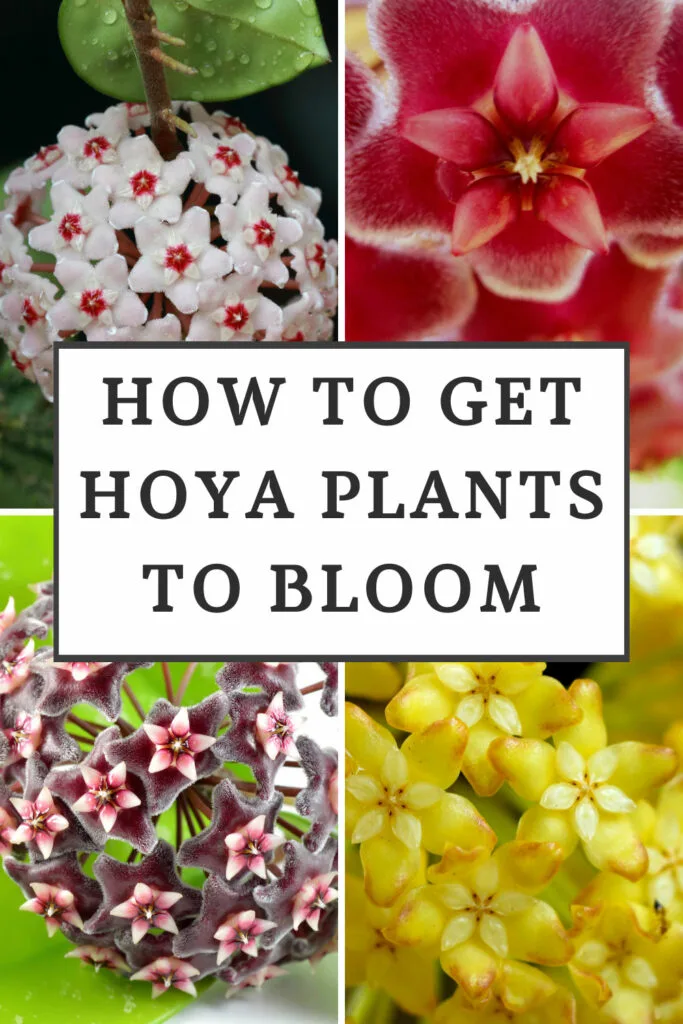
Regardless of the species or cultivar of Hoya that you have, these tips will apply. The Hoya genus contains approximately 545 species.
Some common names for Hoya plants include wax plant and porcelain flower. Native to several countries in southeast Asia and the West Pacific, this tropical plant is well adapted to grow indoors.
Most have thick, waxy leaves and the star-shaped flowers are stunning, coming in various colors such as red, orange, pink, red, green, yellow, and white. Many of them have a beautifully sweet fragrance as well.
Table of Contents
HOW TO GET HOYA PLANTS TO BLOOM
Here are the main factors to encourage Hoya flowers:
Table of Contents
Hoyas are one of the best indoor plants to grow, and providing the right conditions for your Hoya will result in the best flower show possible. Here are some very important tips on getting your Hoyas to bloom:
1. BRIGHT LIGHT IS REQUIRED
The most important factor to trigger Hoya flowers is to ensure that you have sufficient light levels. The common (but very vague) advice is to provide bright indirect light in order to encourage Hoya blooms. Practically speaking, what does this mean?
Like any flowering plant, light is of paramount importance, and if you have your plant in low light conditions, your Hoya will refuse to bloom. And there isn’t as much light indoors as you think.
Here are some tips on situating your Hoya in your home in order to help trigger your plant to bloom:
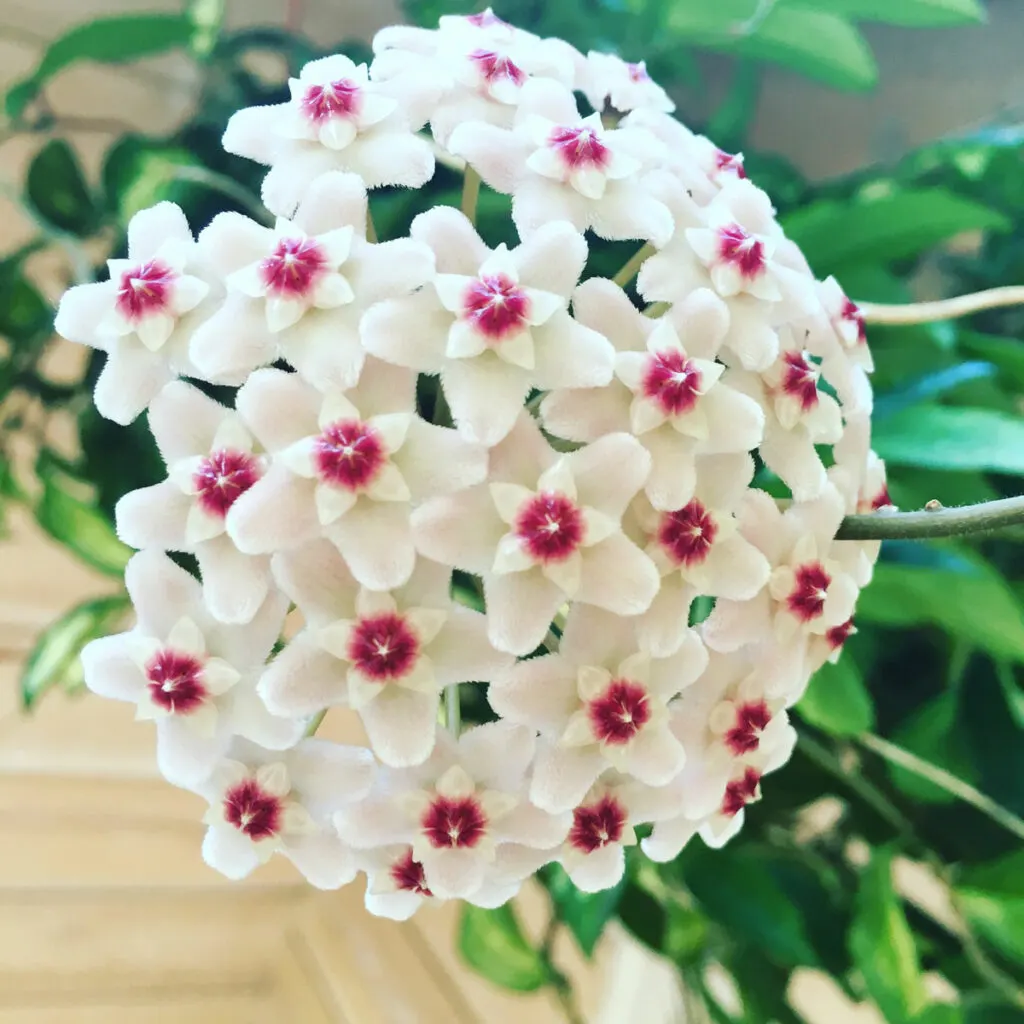
- Always have your Hoya plant immediately in front of a window. Light intensity decreases dramatically even 1-3 feet away from a window.
- Depending on where you live and how large your windows are, and if there are any obstructions such as trees, a window with no direct sun at all may not be enough. Consider an unobstructed East-facing window that provides a few hours of gentler morning sun. A West-facing window that gets late afternoon sun is also great. Windows that get full sun all day may be too much, unless you live in an area with dark winters, in which case, your plant will appreciate the additional light during the winter months!
- Do you want a more objective way to measure light? Invest in an inexpensive light meter. The University of Florida recommends light intensities of 1500-2000 foot-candles of light for best plant development.
- If you are blessed with windows that get a lot of direct sun most of the day, you can gently diffuse the light with a sheer curtain if you need to.
- If you don’t have any good windows available, a simple solution to resolve low light situations is to use grow lights. You can use artificial light to supplement your natural light in front of any windows, or you can place your grow lights anywhere you’d like to grow your plants in your home. Hoyas will grow beautifully and bloom well under grow lights. Keep the grow lights on at LEAST 12 hours a day. If you want to encourage blooming, keep them on for 14-16 hours per day.
- During the summer months, if you have any shady outdoor spaces, it will benefit your Hoya to spend some time outdoors. Wait until evening temperatures are at least 55°F (13°C) consistently, and place your plants in complete shade outside. Remember a shady location outside is probably higher light than most locations inside your home. Dappled sun under a tree would be a perfect location. Be careful with direct sun exposure outdoors. They can take some sun outside, but you will need to acclimate your plant slowly enough so that it doesn’t burn. Check out my blog post on acclimating your plants to the outdoors so that you avoid burning your beloved plants.
- Your Hoya plant will definitely survive in low light, but don’t expect it to bloom (or grow much) in lower light conditions.
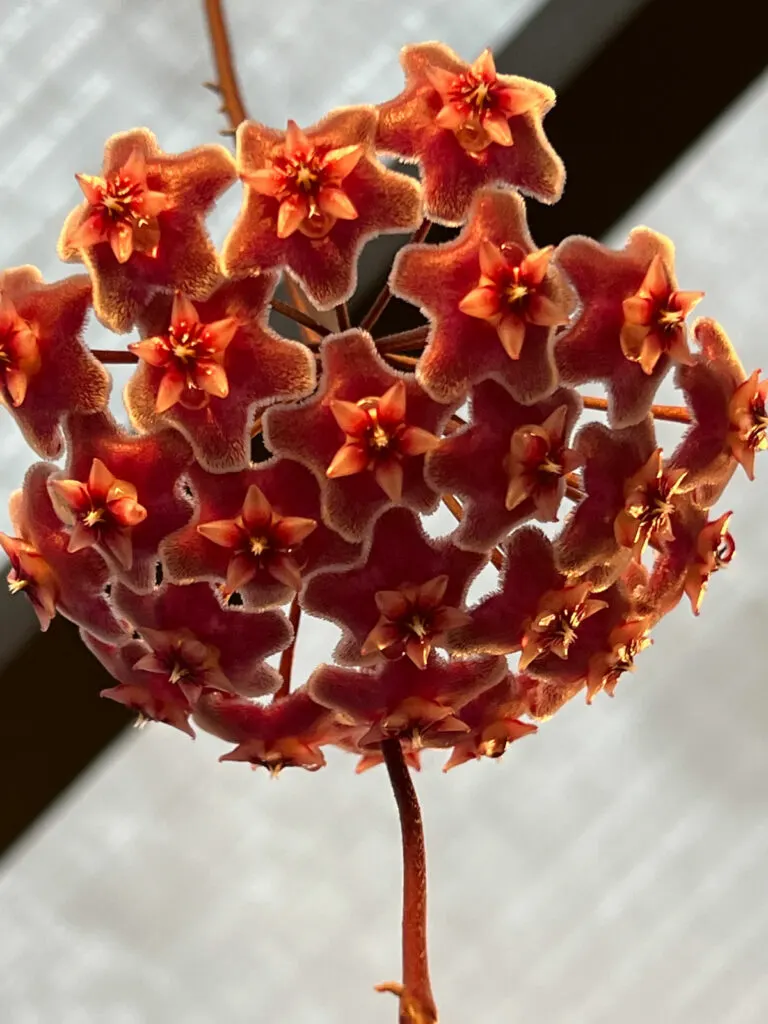
2. YOUR HOYA PLANT NEEDS TO BE OLD ENOUGH
The age of your Hoya plant will definitely affect if it is ready to bloom. The International Hoya Association states that many species of Hoya will bloom in their first year of growing, but others may need 2-3 years or more before they are mature enough.
However, if your growing conditions are not good enough (namely light), your Hoya may never bloom even if it is old enough.
3. FERTILIZATION FOR THE MOST FLOWERS
Using a well-balanced fertilizer is an important part in your Hoya’s health and will also affect flowering. One of my favorite liquid fertilizers is Dyna-Gro Grow (link to Amazon) and I use this on all my Hoyas plants.
It is a nutritionally complete fertilizer and it contains all of the macro and micro nutrients need for your Hoya to thrive. It is also urea-free so it will not burn your plant if you use it as directed on the label.
I like to fertilize with every watering (dilutely). This way I don’t have to remember when I last fertilized. I simply use 1/4 to 1/2 teaspoon of Dyna-Gro Grow at every watering when my Hoyas are actively growing.
If you think that your light conditions are good and you’ve been using a balanced fertilizer and still have no flowers, try alternating applications of your normal fertilizer with a bloom booster fertilizer (you can identify these because they have a higher middle number).
A good choice would be Dyna-Gro Bloom (3-12-6) for an extra boost of phosphorus that can help trigger your plant to produce more flowers.
Fertilizing is extremely important particularly if your Hoya has been in the same pot for many years. If your plant is pot bound and has been in the same pot for quite a few years, it is probably in desperate need of nutrients.
If you have gone years without fertilizing, your plant will eventually suffer and may start to exhibit nutrient deficiencies. The International Hoya Association gives the following guidance as far as what nutrient deficiencies may look like in your Hoya.
- Nitrogen deficiencies can manifest themselves as older leaves looking sad, pale and yellowish and may even drop off the plant. Growth will also be slow and stunted.
- Phosphorus deficiencies first manifest themselves in the leaf edges. The edges will turn a reddish or bronze color on the older leaves, and new growth will be stunted or even stop. Leaves will start to turn into a blue-green color with purple/brown/yellow mottling on the leaves.
- Potassium deficiencies will result in the leaf tips and edges turning a bronze or reddish color and edges will eventually look brown and burned. New growth will also be stunted.
If your plant has become really nutrient deficient, start fertilizing regularly. It may not come back as beautifully as it once was, but it should help.
It is best not to get to this point, however, so be sure to fertilize regularly before you start to see any of these severe issues. Dyna-Gro Grow contains all the nutrients that your Hoyas need to thrive, so make it part of your plant care routine.
Macro nutrients like Nitrogen, Phosphorus and Potassium are very important, but so are the trace nutrients that are needed at much lower levels, and Dyna-Gro Grow has them all.
You can also fertilize your Hoya plants by foliar feeding. Many Hoyas grow as epiphytes in nature and they absorb many nutrients through their leaves.
You can mimic this by using Dyna-Gro Grow to spray your entire plant with a fertilizer solution. There is a recommended concentration on the label that you can follow.
4. KEEP YOUR HOYA ROOT BOUND
Generally, plants will produce more flowers when they are fairly root bound, so avoid overly large pots. When it comes time to repot your Hoya, I recommend that your new pot should only be 2 inches in diameter bigger than the old pot and no larger.
For example, if your Hoya is currently in a 4 inch diameter pot, only go up to a 6 inch diameter pot and no bigger.
The best time to repot is when your Hoya is just about to start into a period of active growth (most times, this will be around early spring), although they are resilient and can be done anytime that you need to.
Another reason not to use pots that are too big is that the excess volume of soil will take too long to dry out, particularly if your plant is sitting in lower light.
Always use pots with drainage holes. Hoyas demand excellent drainage, otherwise excess water accumulating in your pot will cause root rot.
Always use a well-draining soil. A good potting mix blend for Hoyas that I like is two parts of a good all-purpose potting mix and 1 part of 1/4″ horticultural pumice.
If you want an amazing mix to use right out of the bag, check out the amazing Hoya soil blend from Oh Happy Plants. This is an amazing mix and you will get 10% off at checkout automatically if you use my link.
5. CONSIDER A DRY REST PERIOD
If all else fails, you can try providing a dry rest period in the winter time. I did this with my Hoya carnosa one year and it worked. If your Hoya species is supposed to bloom in the Spring, give it a 4-5 week dry period in the winter time. Sometimes this will help to trigger blooming.
OTHER IMPORTANT CARE TIPS FOR HOYA FLOWERING
PRUNING
Should you be pruning your Hoyas? First off, Hoyas will rebloom every year from their bloom spurs. After the petals fall off, the spur will remain and it will bloom in that exact location the following year.
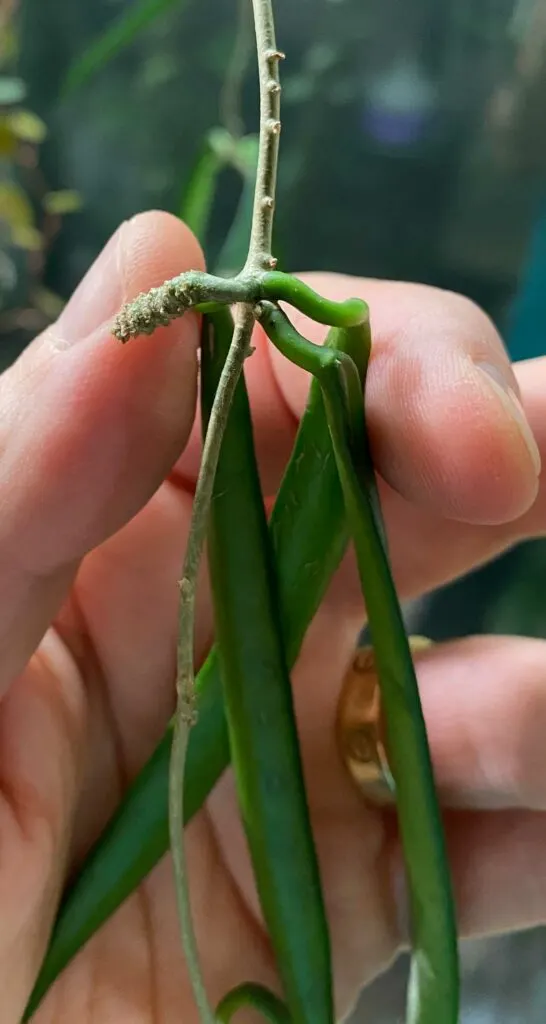
However, if you want to sacrifice some flowers temporarily and give your plant an opportunity to really provide a huge show of flowers, go ahead and prune your plant up a bit.
Pruning your Hoya will force a lot of new vines to grow, and create a bushier, fuller plant with a lot more flowers.
HUMIDITY
Hoyas are very resilient when it comes to humidity levels, but they will grow and bloom better with adequate humidity levels. Try and maintain humidity levels of 40-60% for best results.
If your humidity is too low, particularly in the winter time the tips of your vines can appear to burn and your plant will also be more prone to spider mites.
Combat that air dry with a good humidifier. Your plants and your skin will benefit!
SEASONALITY
Depending on the Hoyas species, they will bloom at different times. While some can bloom year-round, some only bloom in Spring or Summer, while others will flower in Fall or Winter.
Do your research so you know what to expect for your particular plant.
TEMPERATURE
If you keep your Hoyas too cool, growth and flowering may be reduced. An optimal temperature range to grow Hoyas is 68-75°F (20-24°C), which is basically room temperature in any home, so this shouldn’t normally be an issue.
I hope you’ve enjoyed this post on how to get Hoya plants to bloom. Do you have any blooming Hoyas? Comment below. I’d love to hear!

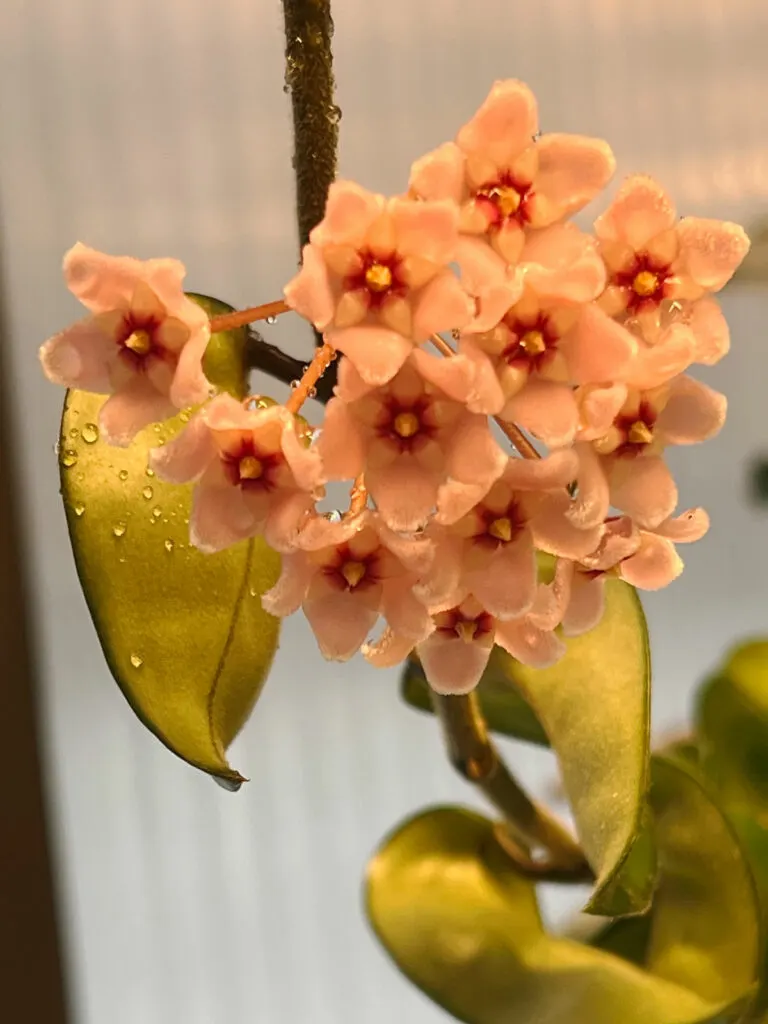
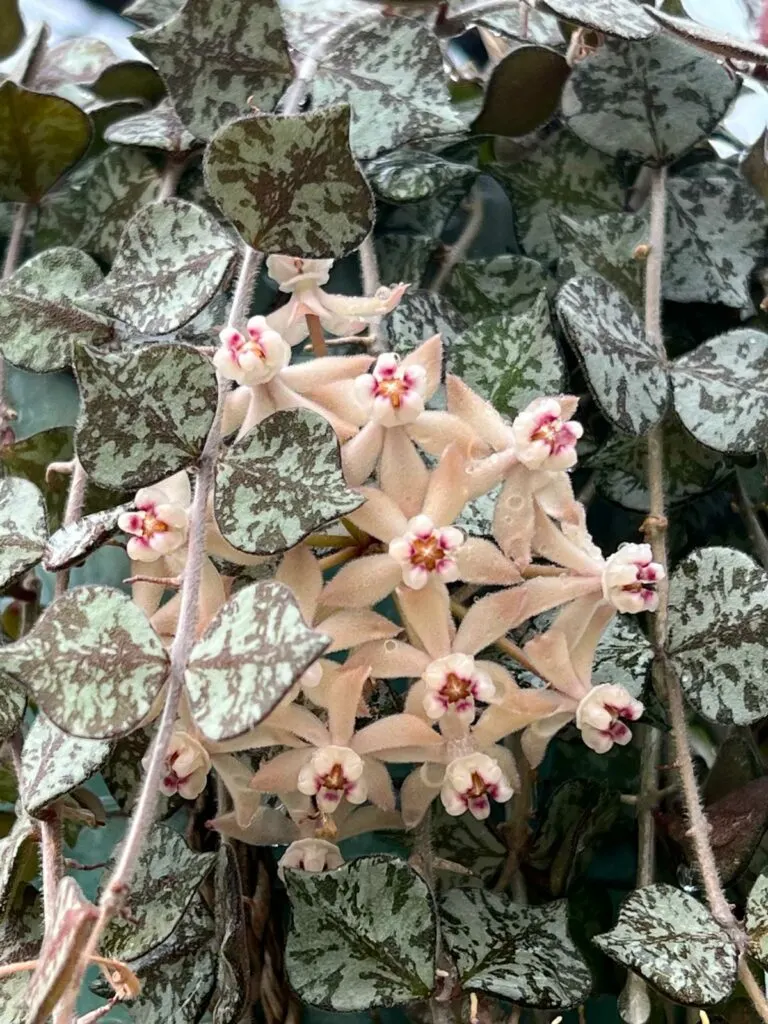
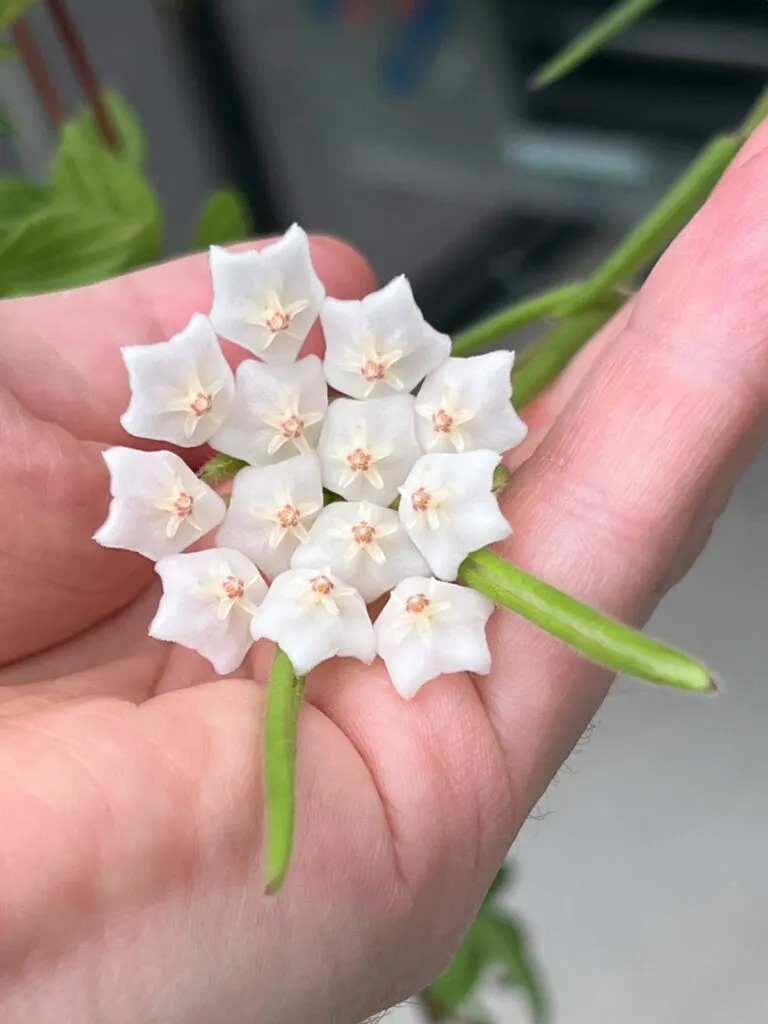
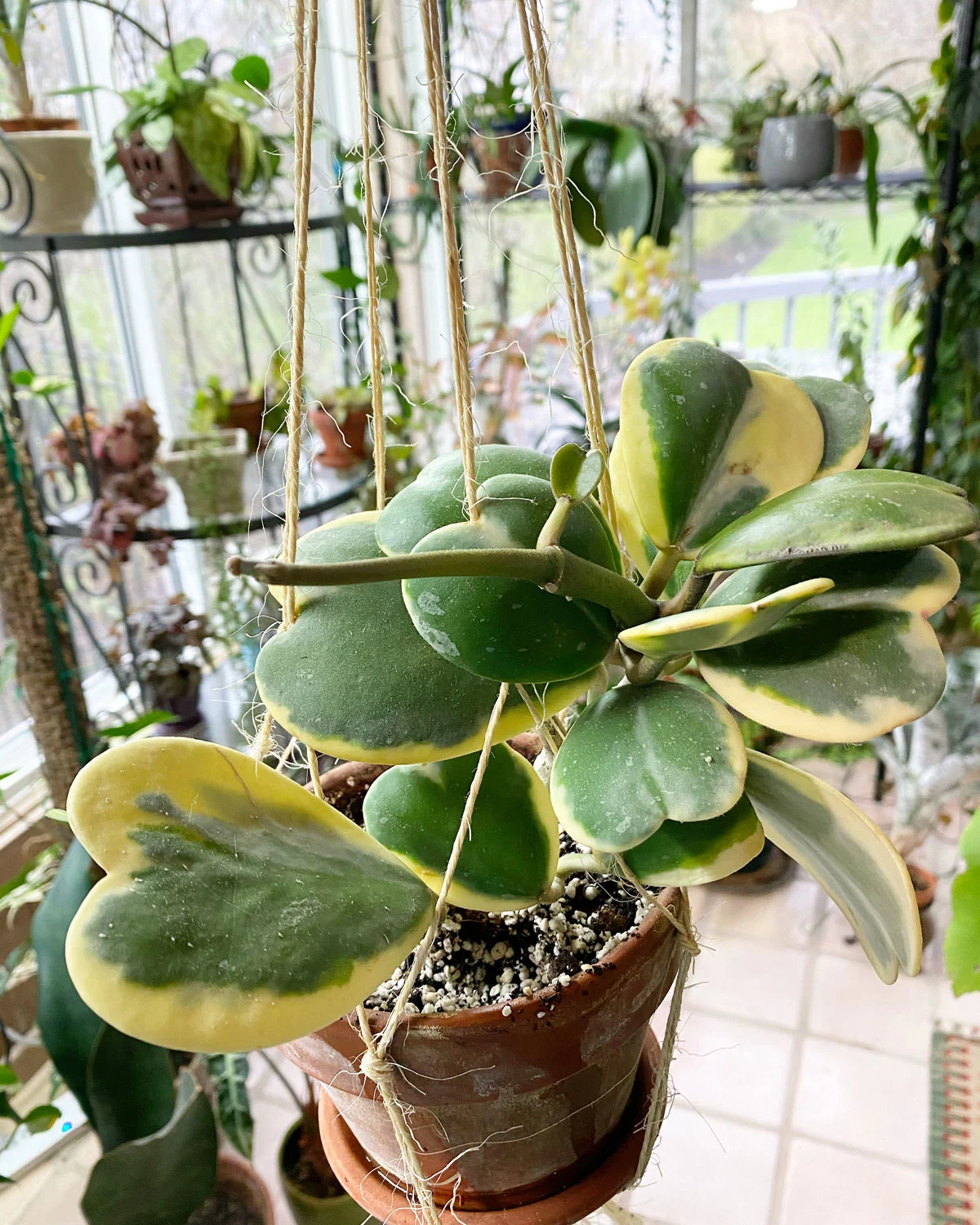
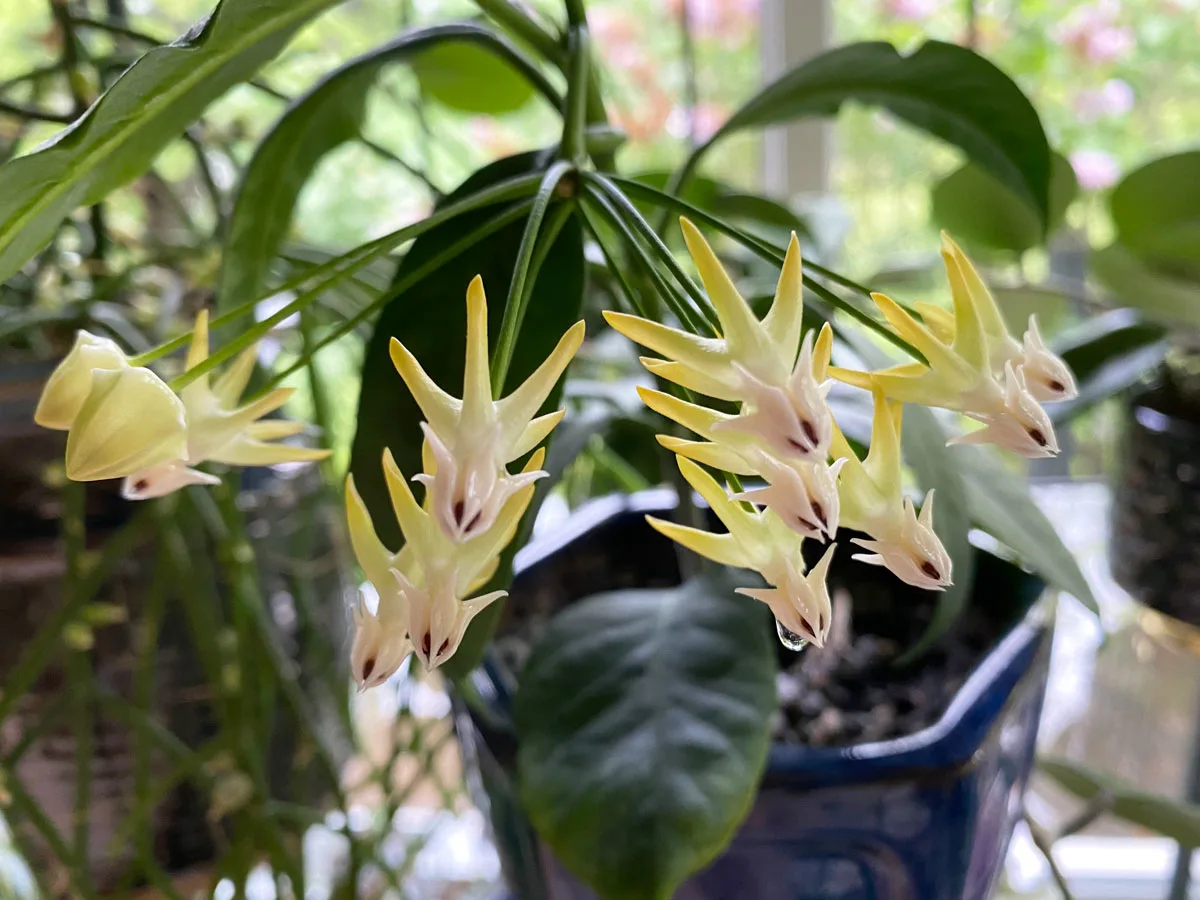
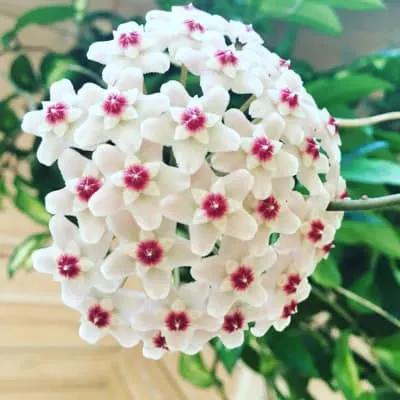
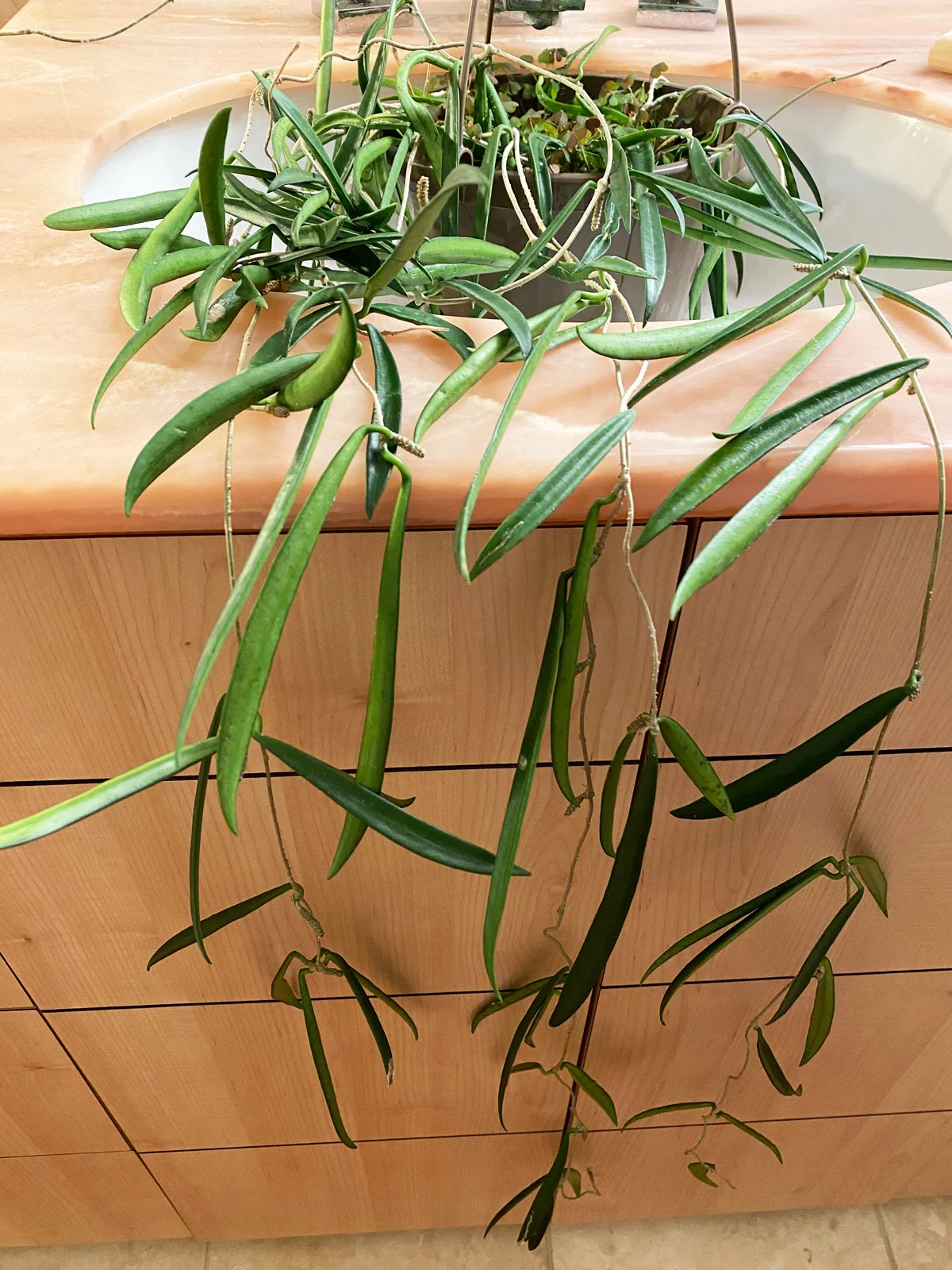
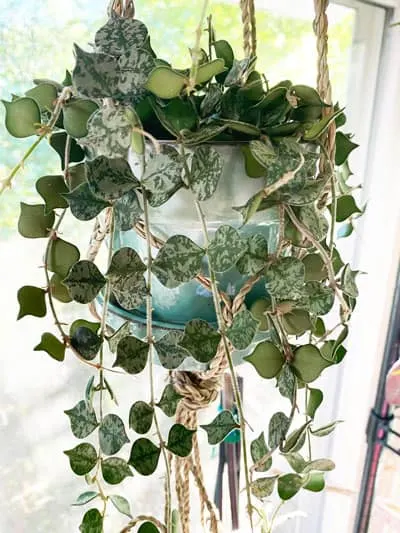
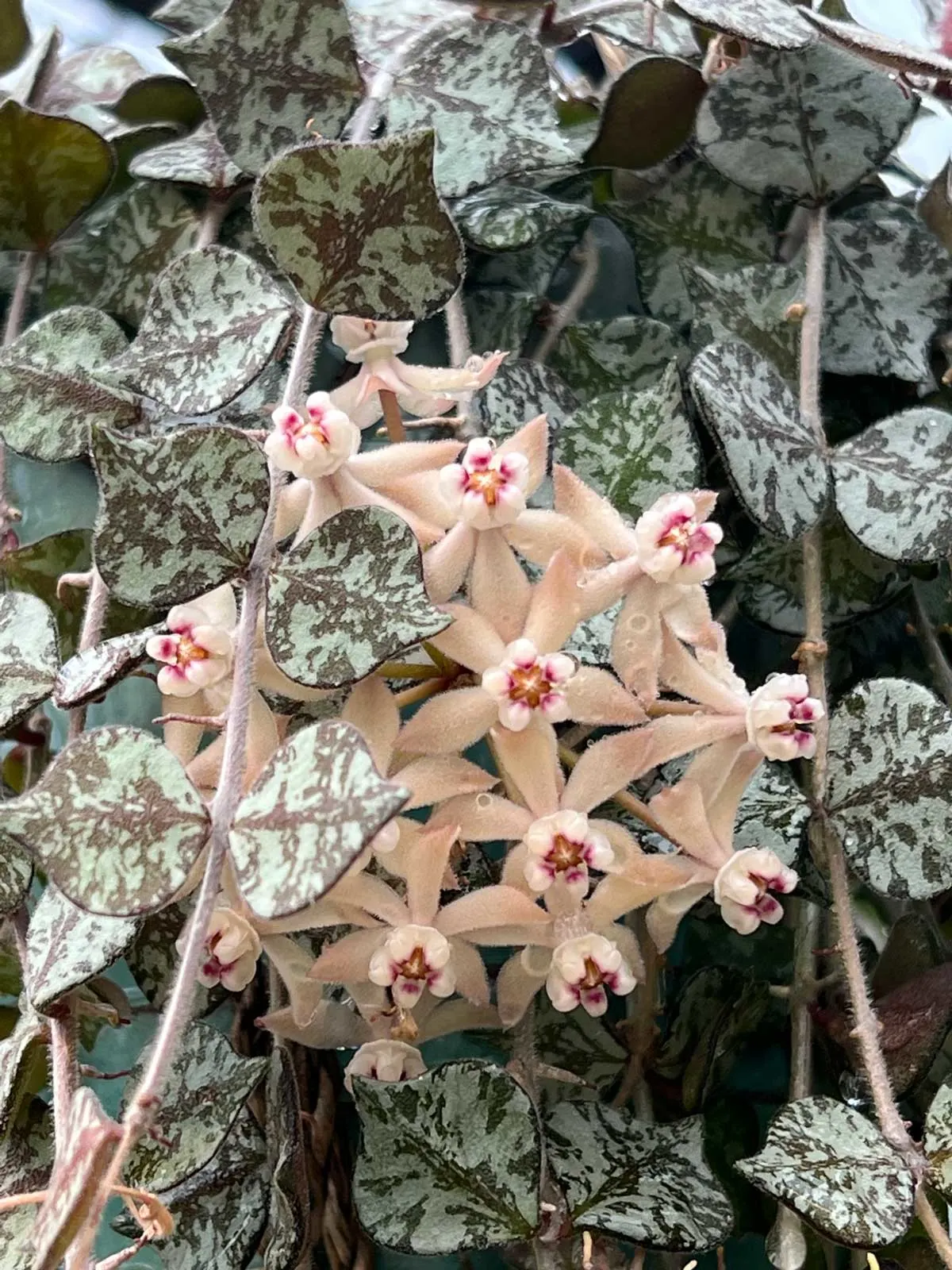
Deb
Wednesday 28th of February 2024
I have 13 different Hoya plants....they are my absolute favorite. However, I am having a horrible, terrible time with Mealybugs. My Hoya are in plastic hanging baskets and in ceramic bowls. North window with grow lights. My window is almost 8 feet long, so I can put several Hoya in that space. They are all growing, getting new leaves...but those awful Mealies!! I have tried everything! What can I do?? I don't want to lose my collection I've had for over 7 years!!
Raffaele Di Lallo
Wednesday 28th of February 2024
Hi Deb! Sorry to hear about the mealies! They are frustrating for sure...I will refer you to my mealybug post where I describe exactly what to do: https://www.ohiotropics.com/2023/11/14/how-to-treat-mealy-bugs-on-plants/
Sylvia Murray
Thursday 16th of November 2023
I thoroughly enjoyed reading your very informative article. Last year I was given a number of Hoya cuttings. I kept the cuttings in water for a while and I eventually planted them into plastic pots. I water them very regularly and I have the pots sitting in shallow dishes filled with water. They have all thrived and I noticed 2 of them have flowers starting to appear. After having read your article, I am now confused as to how I should continue to look after these beautiful plants. Do I leave them where they are and keep an eye on any changes or do I give them a dry spell? I live in Sydney, Australia. Thank you in advance for any advice you can provide. Regards Sylvia.
Raffaele
Thursday 16th of November 2023
Hi Sylvia! I'm glad you enjoyed the article. It sounds like you're doing just fine though, so I would keep doing what you're doing! If you have trouble with flowering in the future, you can try some of the tips, such as the dry spell, if you need to.
Adrienne Aislabie
Thursday 7th of September 2023
Our Hoya is well over 40 years old and has become a family plant . We have repotted it several times and it has flowered well. We have had few flowers now for several years .We have it at the front door which doesn’t get a lot of sun, Guess it could be a bit dark there as well.should we place it on a deck that gets morning sun and sun most of the day
Raffaele
Thursday 7th of September 2023
You can definitely put it outside, but a word of warning...before you expose your plant to any direct sun outside, place it in full shade for a few days. Then gradually increase the sun little by little. Maybe by half an hour a day, slowly. If you move your plant immediately into direct sun outdoors, it will burn pretty quickly. As long as you slowly acclimate your plant, it will love it! You'll also want to consider checking for pests and maybe preventatively spraying your plant before bringing it back indoors. Temperature is important too so be aware if you live in a climate that gets too cold. I hope this helps a bit!
Jenn
Sunday 25th of June 2023
In regards to ideal temperature for a Hoya.. can the ideal temp go lower during the winter months? I live in a northern climate with really cold winters and keep my indoor temps around 62F but the only room with south window for light is the bathroom- good for humidity when I run the shower but that room is colder than the rest of the house. If the cooler temps are lasting around 3 months, is that going to be too cool for the hoya?
Jenn
Friday 30th of June 2023
@Raffaele, it has 3 exterior walls so when the weather is really cold out it can get 10 degrees lower than the center of the house. I would say the coldest is about 52F.
Raffaele
Monday 26th of June 2023
Hi Jenn! How cool would you say it gets in your bathroom? It likely will be just fine, but I'm wondering what kind of temps you're seeing in there (minimum temp).
Brenda
Friday 7th of April 2023
Hi, I would like to start using the product that you mentioned in your article. What is the strength (numbers) of Dyna Gro Grow that I should be using on my Hoyas? I plan on getting the Dyna Gro Bloom too. I really enjoyed reading your article on Hoyas. I currently have several new ones and look forward in the years to come of them blooming.
Raffaele
Thursday 13th of April 2023
Yes, you can definitely use Dyna-Gro Grow, and maybe use the Bloom version in late winter to early spring to encourage blooming (assuming your plant is getting enough light!)